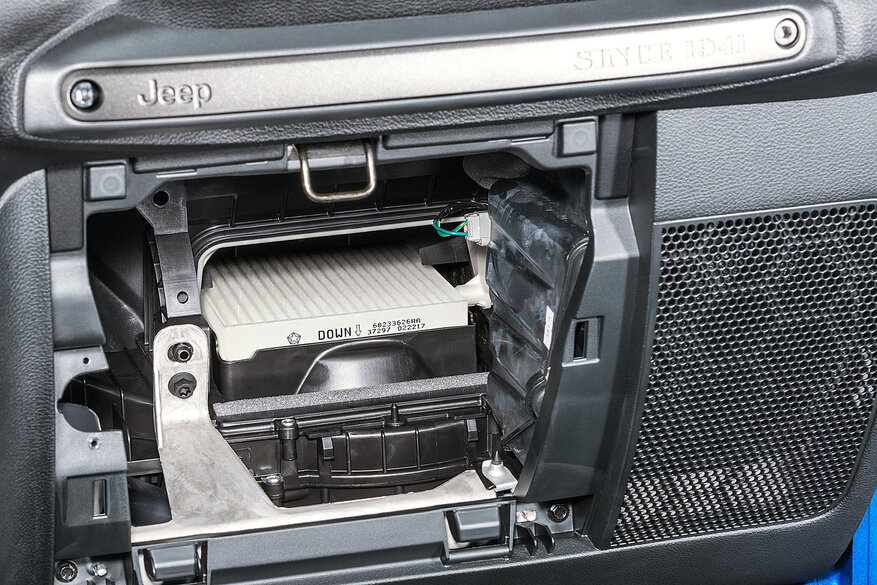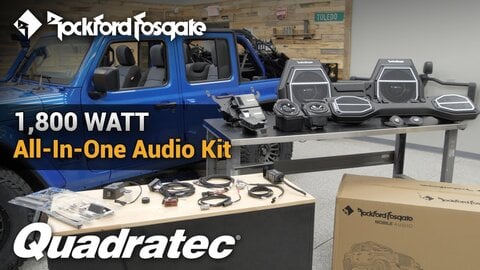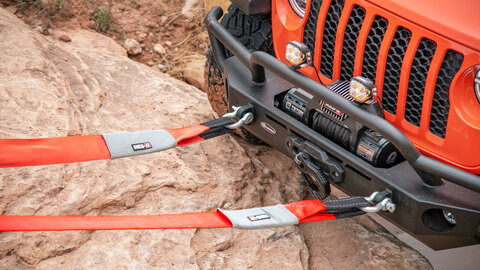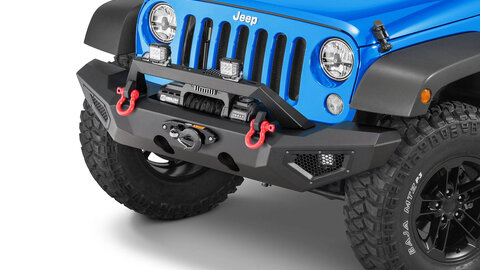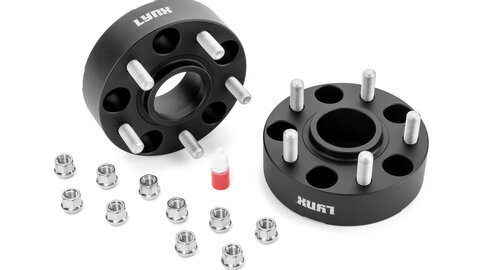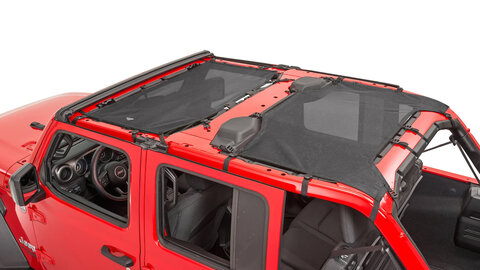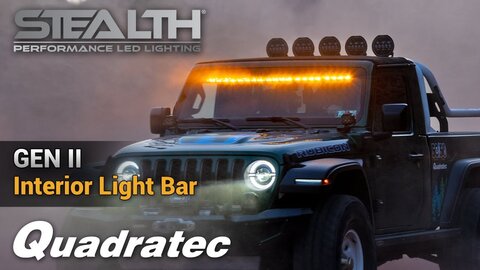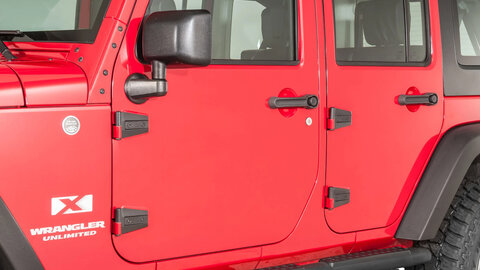by Matt Konkle
Managing Editor
The air feels just a little fresher this time of year. A little cleaner, perhaps. Something full of possibilities and excitement.
That is spring for you; a time of rebirth when there is a whole clean slate of days stretching ahead and ready to be molded into whatever works best for you.
It is also that time of year when many choose to look around and see what exactly needs to be freshened up or tossed out for something new.
And just like you clean out the garage, porch, attic, or whatever during a nice spring weekend, you can also put a few hours aside and take stock of that Jeep because it may need some love as well.
So as the trees and grass take shape and gain color this spring season, here are a few things that generally prove most popular to examine, maintain and, if needed, get replaced on your Jeep.

Soft Tops
You may not think your Jeep’s soft top really needs any maintenance. Just zip out the windows when you want and unclip to take down, then reverse the process when you want the top back up to cover. After all, that material is pretty thick, right? It will last.
And it will — usually. For a while.
Soft tops, though, do not play nice overall with the cold and warm weather changes. And over time, this means material can stretch out, tear, have zipper issues, or no longer attach to the hardware like it did when you first bought the vehicle.
Now, not all this stuff happens instantaneously. But there can be enough of a problem coming out of the winter that causes your top to demand some spring maintenance attention.
If that sounds like you right about now, you are not alone. This is why Bestop offers handy Replace-a-Top fabric-only solutions that work well with your factory Jeep hardware. Not only does this save you time and money when replacing, but you know it will fit perfectly because this is the company that created your OEM soft top in the first place.
All Replace-a-Tops are offered in factory-matched material, while some allow you to upgrade into the thicker twill or sailcloth variety. Also, depending on your current door situation, you can choose to just get the top itself with no doors — saving you even more.
Plus, Replace-a-Top versions are offered in all the factory color options so you can match what you had originally to keep your Jeep looking, and performing, at its best.

Brake Kits
Your Jeep’s brakes are its first line of defense when it comes to safety. After all, they are really the only acceptable thing to stop the vehicle when needed. The emergency brake is not all that practical and, well, just running into something kind of defeats the whole purpose of why you want to stop in the first place.
So, after a long, cold and messy winter, one of the first things to check on your Jeep this spring should be the brakes — especially if the whole system is becoming a little long in the tooth.
Some signs you’ll want to pay attention to when checking on brakes include a burning odor from the front or rear brake area, squealing or screeching when braking, grinding noise when the brakes are applied, pulsation or vibrating in the steering wheel or brake pedal, mushy brake pedal, the Jeep pulling to one side while braking and the old reliable brake light illuminating on your dash.
Another thing to consider is if you’ve recently upgraded to larger tires and wider wheels, as well as heavy items like new bumpers, cargo racks, or side bars, as all those things can put more strain on your factory brake components.
These days, Jeep recommends inspecting those pads starting around 20,000 miles and then looking at rotors around 70,000, but in reality, you can inspect them every time you rotate your tires. Keep in mind that recommendations are only as solid as the way you drive, and wear on your brake components really depends heavily on your driving habits. If the vehicle is a daily driver and you always seem to be in stop-and-go traffic, then the pads will most likely wear down faster. The same thing applies if you are a frequent off-roader.
Now, whether you’ve added those larger tires and other heavier items, or it is just time for a change, Powerstop Brake Performance Kits are an excellent upgrade over the factory components. These aftermarket kits include all new ceramic-coated brake pads that help reduce brake dust and wear over time, while adding much-needed stopping power. The kit’s beefier rotors are machined and balanced to exactly fit your Jeep and are drilled — as well as slotted — to reduce warping and heat.
These kits come in daily driver, sport, or extreme packages so there are plenty of options depending on how you drive.

Cabin Air Filters
Just like fresh air is great to inhale during these spring months, so is having that nice, fresh air inside your Jeep’s cabin. However, that may not be the case for you right now following a long, dusty, dirty winter that most likely affected your cabin air filter.
These pieces are usually located behind the glove box and help filter out stuff like dust, dirt and other nasty particles before they invade your cabin — thus keeping air nice and fresh.
Typically, these filters need to be swapped out around every 20,000 miles which is a simple enough process of removing the glove box door, pulling out the old filter, and replacing with either a factory or aftermarket version.
However, like a lot of other maintenance stuff for your Jeep, there are always other factors that could affect the lifespan of that product. For example, if you are a regular off-roader then you’ll want to check that filter more frequently as dusty trails will cause it to clog up faster than simply on-road driving. Additionally, if that daily road driving includes dirt roads from time to time, then that road dust could also factor into the filter’s lifespan.
Whether you choose a Mopar replacement, or aftermarket product from Crown, Omix, or K&N, these new filters are ready to shield your vehicle’s interior from all that dust, dirt, or even pollen during these spring months — and beyond. Not only that, but these filters also help keep those contaminants out of the Jeep’s HVAC system, which helps lengthen its lifespan as well.
Additionally, many choose the K&N filter these days as a long-lasting replacement because this product can be removed when it gets dirty, washed and then replaced — while the other styles need to be tossed in the trash when their time is done.
Now, some Wranglers came from the factory without any filter at all, so if you can’t find one in yours then all you need to do is add a factory or aftermarket replacement as the Jeep still has that space to add the filter behind the glove box door.

Fluids
One of the bigger things people tend to forget when prepping their Jeeps for Spring, is ensuring proper fluid levels on the vehicle. And that's because most spend a lot of time inspecting the exterior of the vehicle for stuff like tire issues, top problems, rusting, etc. So, while those are all good things to inspect and deal with, make sure not to skip some of the items that really keep the Jeep moving.
Obviously oil is right up there at the top, and depending on how much you drive the vehicle, you may be ready for that next oil change as we slide closer into Spring — especially if you've been putting it off the past few cold months.
Whether you do it yourself or take it to a dealership/mechanic, having clean oil to start the season will keep your engine happy and ensure plenty of fun days ahead. Also, DIY changes are not difficult and will save you money. If you haven't tried one before, we have advice for those with JK editions or 3.6L JL models, as well as the 2.0L 4xe.
Besides oil, refilling your Jeep's washer fluid reservoir can be important as well. Grimy, dirty winter months usually deplete that wiper fluid so make sure to grab a bottle and replenish. Your windshield will thank you.
Other fluids should be inspected as well, including transfer case, brake fluid, coolant, and differential — if only to ensure they are at proper levels. These normally have a longer lifespan than, say, oil, but if something looks low or just seems off, you can replace yourself or take the Jeep somewhere to have the fluids changed.

Spark Plugs
No matter how you start your Jeep — a key, button, or even a remote — there are a lot of things that go into that engine actually firing up and rumbling to life.
And one of the biggest things in that process is also one of the smallest.
Your Jeep’s spark plugs.
Spark plugs are essential to the ignition system and no matter what else you’ve done to your vehicle, it isn’t going anywhere if the spark plugs do not work. Even if those plugs do fire up the engine, they may not be in the best of shape which will cause poor fuel economy (not a good thing at the moment), as well as slow acceleration.
Besides those two issues, you may also hear a rough idle in the engine, misfiring, a slow start when you turn that key or press the ignition button, or simply the check engine light is now illuminated on the dash.
Basically, these plugs deliver electric current from your Jeep's ignition system to the combustion cylinder to ignite the compressed fuel / air mixture. It consists of a metal threaded shell, electrically isolated from a central electrode by a porcelain insulator and is connected to the ignition system with a spark plug wire. Without the spark of electricity created by spark plugs, your engine doesn’t have the combustion it needs to start — which could leave you stranded on the road or trail.
In most cases, Jeep recommends changing over the factory plugs on older Jeeps about every 30,000 miles to keep the engine working at its best. Newer Wranglers could see that schedule increased to 60,000 or even 100,000 miles depending on your engine, so it is always best to check your vehicle’s owner’s manual for the recommended replacement time.
However, even if you have not reached those mileage amounts and are starting to see some of those fuel, acceleration, or starting issues, it is probably a good time to check those plugs and replace as needed.
Factory, or factory-style replacements, are certainly acceptable and get the job done, but just make sure to do the research and buy ones for both your vehicle’s year and engine type as some Wranglers have multiple engine types.
Aftermarket plugs, especially ones by E3, have proven extremely popular because these use a unique ground electrode that encourages more turbulence in the air/fuel mixture. This leads to a more complete burn of the available fuel and the downstream benefits of improvements in power, fuel efficiency and reduced emissions.
In some cases, this DiamondFire ground electrode design can actually increase horsepower and torque between three to six percent, as well as a slight boost in fuel economy as well.












